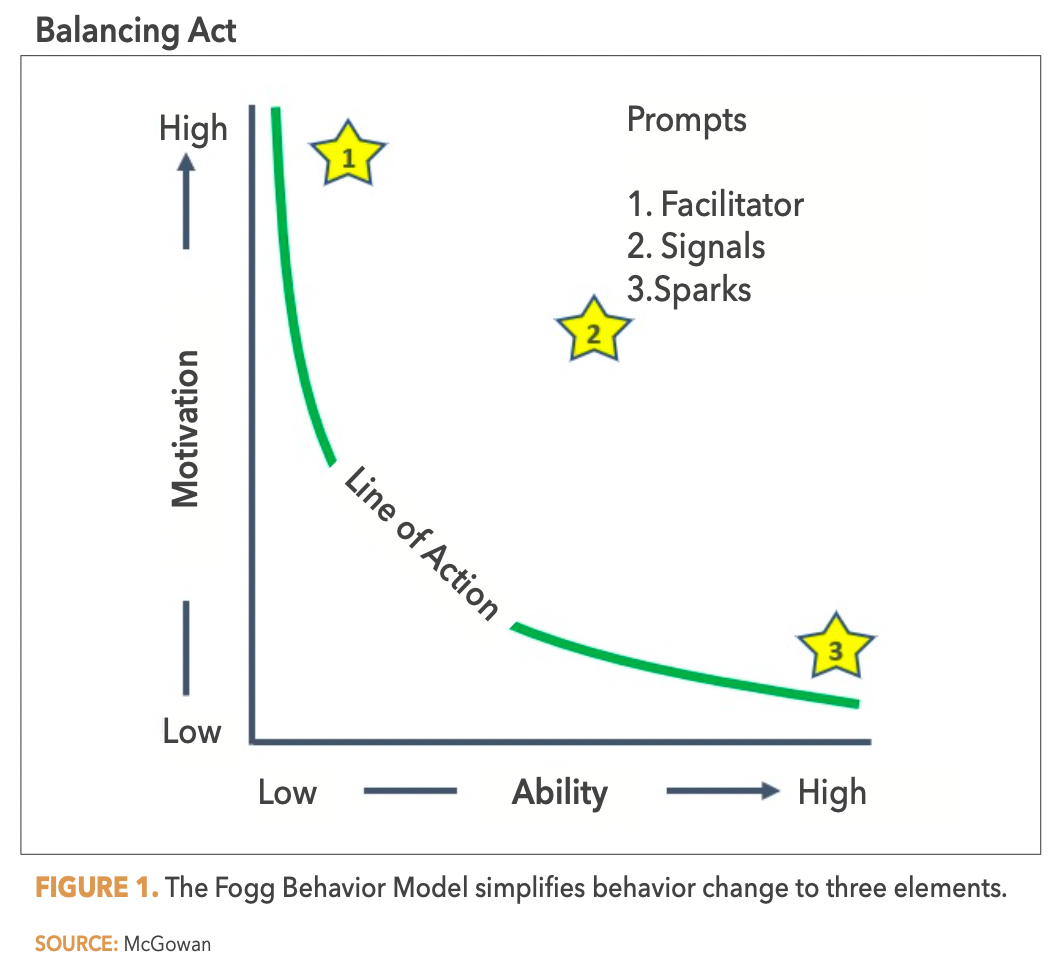Changing Behavior: Knowing Doesn’t Equal Doing
Applying elements from the Fogg Behavioral Model to ease trial complexity.

In the first article in this series, published earlier this year, I introduced the idea that much of what challenges the clinical trials community can be overcome by applying best practices from cognitive science (how we think/decide), learning science (how we train/learn), and behavioral science (how we change/perform). These are lessons that are used in a wide variety of fields and an even wider variety of settings, but have seemingly gained little-to-no traction in clinical research. In the second article in this series, published in May, I introduced the Stages of Change model as one such, well-established best practice. Namely, change is not a simple yes/no binary event, instead each individual progresses on their own journey of change. As a result, enabling a specific behavior change often requires different interventions for different individuals at each different stage of change.
In this article I’d like to introduce a second, complementary model (or best practice) from behavioral science–one that I believe is the simplest and most actionable model for supporting specific behaviors to change–and one that should guide every step of what we do in clinical research, from protocol design, to site selection, to study site start-up, to patient recruitment. Remember: each step or requirement in a clinical trial should be seen as a classic example of behavior change.
The Fogg Behavioral Model
First published in 2009, the Fogg Behavior Model (FBM) simplifies behavior change to three elements: motivation, ability, and prompts.1 All three elements must be sufficiently balanced for a change to occur (see Figure 1 below).

Motivation is rather straight-forward, it is the general desire or drive that one has to make a change.
What’s important here is that the clinical research community has historically made some maverick miscalculations, overestimating the motivations of investigators, site staff, or patients. Instead, best practices from behavioral science suggest that stakeholder motivations should be carefully considered and monitored and that specific efforts should be implemented to ensure motivations are aligned and sufficient to empower sites, staff, and patients to execute trials and maintain compliance. This is one of the most important outcomes of effective trial-related training.
Ability is a bit more complex; but is actually quite intuitive. In the context of a clinical trial, the FBM suggests that there are four things that either enhance one’s ability to change (simplifying the target behavior) or undermine one’s ability to change (complicating the target behavior).
- Time. If a target behavior requires time and you don’t have time, then the behavior is not simple. For example, if an informed consent workflow takes 45 minutes to complete, but could have been designed to be completed in 15 minutes, then the design of the trial lowered the ability for site staff to change.
- Physical effort. The more physical effort a target behavior requires, the more complicated it becomes. For example, if trial participation requires a patient to passively consume a static 30-page informed consent form, that could have been more effectively presented, then the design of the trial lowered the ability for a patient to engage.
- Cognitive load. If performing a target behavior requires us to think hard and apply knowledge that is not well developed, then the behavior is not simple. In essence, thinking deeply or thinking in new ways can be difficult. For example, if site training was implemented as a “check-the-box” experience or not informed by sound instructional design, then staff will lack the knowledge or competence (and motivation) required to perform their role on the study and the ability of site staff will be undermined.
- Novelty. Finally, if a target behavior is unlike prior experience or behaviors, this novelty complicates the behavior and undermines one’s ability to change. In general, people tend to find behaviors simple if they are routine actions that they perform over and over again and/or are easily related to routine actions. While it’s to be expected that a trial of a new agent, new indication, or new device will require some new behaviors, the ability for site staff to effectively execute a trial protocol will be undermined if these new behaviors are not largely anchored to routine actions or staff are not provided robust support or training to practice and gain mastery.
In general, to increase an individual’s ability to change or perform: a) the individual must develop the knowledge and skill through effective training, and b) the target behavior itself should be ruthlessly simplified. Effective training and simplicity are the universal best practices to overcome the challenges of time, physical effort, cognitive load, and novelty.
Prompts are environmental influences that nudge one to make a change. The shape or form of a prompt doesn’t matter as long as it is available, effectively associated with a target behavior, and presented to users at a moment when the action should be taken. The FBM describes three types of prompts:
- A facilitator is a prompt that enhances ability. When a behavior is challenging, a facilitator can make it easier. The most widely implemented example of a facilitator is pre-setting default options on a form.
- A spark is a prompt that enhances motivation. When a user lacks motivation, a spark can provide purpose. Examples of sparks range from warning labels that highlight risks, to brief patient/survivor videos that inspire hope.
- A signal is a prompt that simply serves as a reminder. When a behavior is easy and a user has motivation, a signal creates a mindful moment of action. Examples of a signal include designed learning moments in training experiences that (re)focus a learner’s attention and remind learners to reflect on critical elements of the training content.
The idea of prompts extends well beyond the FBM. In 2017 the Nobel Prize in Economics was awarded for the work of Richard Thaler on nudge theory and Thaler’s 2009 book, Nudge, has sold over 2 million copies and given rise to more than 400 “nudge units” in governments and healthcare systems around the world.Regardless of what you call them, nearly two decades of research in behavior science have demonstrated that prompts (or nudges) are often the missing link allowing behavior change efforts to succeed.
The most important lesson from the FBM is that all three elements are necessary and critical, and it is the interplay of the elements that dictates whether change occurs. If principal investigator motivation is excessively low, no level of simplicity or number of prompts will allow change to happen. The same thing applies to other scenarios such as if trial protocols are excessively complex and training is inefficient or ineffective, or if prompts are missing or miss-designed.
Once you embrace the elements of the FBM, it should become increasingly clear that so much of what challenges complex contemporary clinical trials can be overcome by leveraging these best practices. And while they may be new to many of us, they have been successfully applied in other fields for decades. In the end, you might even boil all of this down to one singular root cause: behavior change is hard because we all want to believe that knowing equals doing–and simply put, it’s not that simple.
Reference
- Fogg, B.J. A Behavior Model for Persuasive Design. ACM. 2009, 40 (4), 1-7. https://dl.acm.org/doi/10.1145/1541948.1541999

Putting Collective Insights Into Action to Advance Cancer Care: Key Examples From ASCO 2025
June 27th 2025At ASCO 2025, clinical operations leaders gained critical insights into how AI tools, bispecific antibodies, and evolving treatment paradigms are reshaping trial design, endpoint selection, and patient stratification.
What Can ClinOps Learn from Pre-Clinical?
August 10th 2021Dr. Hanne Bak, Senior Vice President of Preclinical Manufacturing and Process Development at Regeneron speaks about her role at the company as well as their work with monoclonal antibodies, the regulatory side of manufacturing, and more.
2025 DIA Annual Meeting: Why AI and Automation Are Set to Become the New Normal in Clinical Research
June 20th 2025Peter Ronco, CEO, Emmes, shares his long-term vision for artificial intelligence in clinical research, from making automation routine to improving drug discovery, transforming regulatory oversight, reducing animal testing, and promoting ethical, equitable data use worldwide.